
The “There’s Only One” Sunoco ink blotter featuring Mickey and Minnie Mouse from 1939. The blotter, which measures 4” X 7 ½,” uses the “pupil-eyed” Mickey Mouse design developed by animator Fred Moore, who did not do this drawing. The visual of the character’s romance is playing off the advertising slogan “there’s only one,” which is referring to the Blue Sunoco fuel brand, the point of the advertisement. This ink blotter was created using the offset lithography printing process.
The Declaration of Independence, the Constitution of the United States of America, the Magna Carta, and other historical documents throughout the world were written using modest dip pens. A dip pen uses a split nib, usually metal, which is then dipped into ink and used to write on paper or parchment. Documents, letters, and other forms of writing have been written with dip pens for centuries. The earliest known split-nib metal dip pen dates back to the 4th century A.D. in Roman Britain.(1) Fountain pens began to appear in Europe by the 17th century, but they were still known to be unreliable as they stained hands and clothing with ink.(2) In May 1809 to Frederick Fölsch received the first patent for a fountain pen while John Scheffer’s patent of 1819 was the first design to see commercial success. (3) By the mid-1800s, the fountain pen became a conventional writing implement. Yet, throughout the centuries, there was a persistent problem of smearing words or signatures before the ink dried. Hence the invention of an ink blotting powder and eventually blotter paper as a way to hasten ink drying to prevent mishaps.
Ink blotting was initially done by using a delicate, sand-like powder known as ‘pounce’ made from cuttlefish bone, which was sprinkled onto the wet ink to facilitate quicker drying. (4) But the most common form was the use of blotting paper, which is a highly absorbent paper that was first made, by accident, in the 15th century. A worker at a paper mill in England had forgotten to add sizing to a batch of paper during the papermaking process. Sizing is a substance introduced to the paper pulp that adds a filler and glaze “to change the absorption and wear characteristics” of the paper making it less absorbent and a smoother surface for writing. (5) That lousy batch of paper was discarded as scrap. When someone at the mill attempted to write on that paper, the ink absorbed and spread wildly into the paper, making it useless for writing but perfect for blotting ink. The blotter paper was invented, which quickly replaced the pounce as a better and less messy tool of choice for drying fresh scribed ink.
By 1885, Charles Murch patented a way to adhere printable paper to the blotting paper paving the way for publishers and companies to create desktop advertisements. These advertising ink blotters became universally familiar in the office and at home throughout America as well as other parts of the world by the early 1900s. They were used to promote anything from butter to salt to gasoline, auto repair stations, soda, banks, and every other consumer product and service that the public uses. These ink blotters were also used by politicians to give constituents the “candidate’s information on one side, while the absorbent paper on the reverse ensured that the card would linger on a desk for weeks as a reminder of the candidate.” (6)
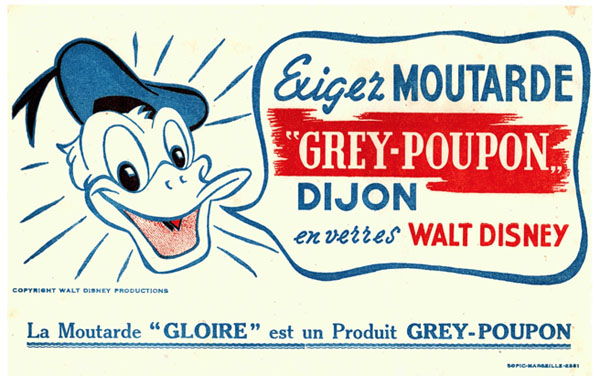
A French ink blotter featuring Donald Duck pitching Grey-Poupon Dijon. Translated into English, Donald is saying, “Require Mustard “Grey-Poupon” Dijon in Walt Disney glasses,” with the tagline below, “The “Glory” Mustard is a Grey-Poupon Product.”
Advertising ink blotters became so ubiquitous that Walt Disney began licensing his animated characters to promote brands from several companies such as Sunoco Oil, Cadum Soap, and B.N. Biscuits on ink blotters among many other things. Donald Duck was even used on ink blotters to pitch Grey Poupon Dijon in France, which in my opinion lacks character integrity oversight.(7) Disney also licensed still images reminiscent of some of his short cartoons for co-branded ink blotters like Donald Duck and his nephews skating, no doubt inspired by The Hockey Champ (1939), for the Arlington Trust Company of Massachusetts in January 1948. Other themes were presented as part of a monthly series of ink blotters for the Arlington Trust Company depicting the Fab Five— Mickey Mouse, Minnie Mouse, Donald Duck, Goofy, and Pluto in various seasonal themes. (8)
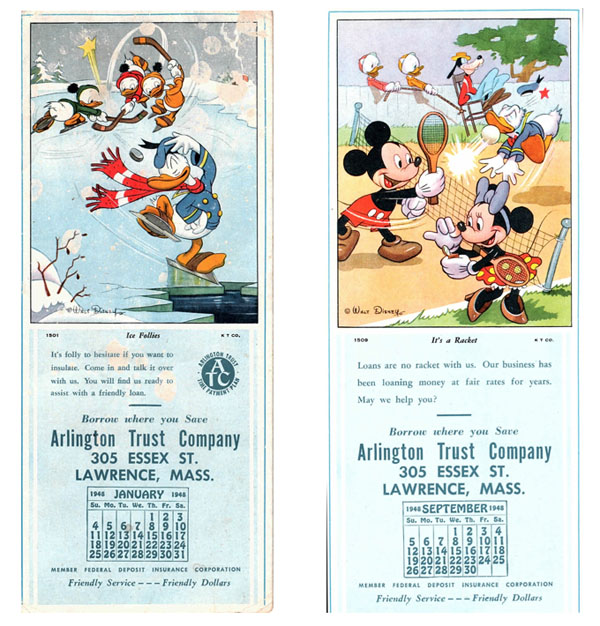
Two in a series of twelve ink blotters issued by Arlington Trust Company, of Massachusetts, in 1948. These ink blotters are somewhat larger that most measuring 3 ¾” X 9” giving the images prominence.
The artwork for these ink blotters was done through the Disney Publicity Production Department by artist Hank Porter, who also created many of the WWII insignia.(9) Porter’s drawings have a pleasing, distinctive appeal to them, and he signed Walt Disney’s name in a very particular way that denotes the work by this artist. According to historian and Hank Porter biographer David Lesjak, he also was one of the few artists who could draw all the characters flawlessly on model. (10) Reviewing Porter’s immense body of work at Disney shows his consistent level of quality and visual acuity in drawing the characters. Regardless of whether the art was used for Military insignia, merchandise, advertisements, or even a simple disposable ink blotter, Porter was a master draftsman. Although Porter was not the only artist working in the Disney Publicity Production Department at that time, he was one of the best. Upon careful examination of the artwork produced from that department, it is not difficult to distinguish Porter’s artwork from other artists in the group as each artist has “tells” in their drawing styles that often act as identifiers.
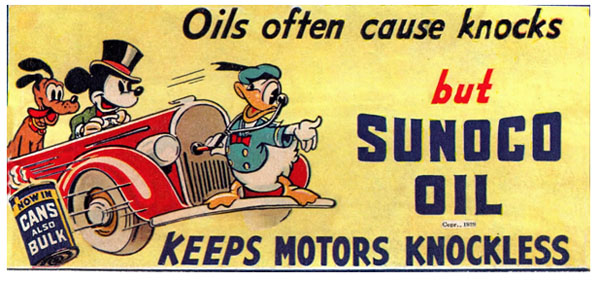
The 1939 “Keeps Motors Knockless” Sunoco ink blotter is using the “coal-eyed” character designs of Mickey Mouse and Pluto more indicative of the early 1930s. By 1939, Mickey Mouse had the “pupil-eyed” design created by animator Fred Moore in 1938. This blotter was clearly in the design transition period and at the beginning of the new license agreement with Disney.
One of the most prominent uses of the Fab Five on ink blotters was with oil company Sunoco, which had a licensing agreement with Disney from 1938-1946.(11) Sunoco is an acronym for the Sun Oil Company of Ohio, which was engaged in producing, refining, transporting, and storing oil, as well as marketing petroleum products through a network of service stations in the United States and Canada. The company revolutionized the oil industry in the 1950s when it introduced the Custom Blending Pump, an innovative “system for dispensing a choice of five octane grades of gasoline from a single pump.” (12) Sunoco had a previous license agreement with Disney in the earlier 1930s, which used the “pie-eyed” Mickey and Minnie Mouse models on gasoline pump plates and other signage at service stations, which proved very successful. The company was aggressive in its marketing efforts for the Sunoco brand of fuel and services. Sunoco expanded the relationship with Disney through a renewed license agreement in 1938, handled by Kay Kamen, that showcased the broader, updated “pupil-eyed,” Fab Five character designs. These characters were used on everything from in-service station banners, porcelain enamel metal signage, ink blotters, placards on the back of taxi cabs, key chains, postcards, and other forms of printed advertisements.
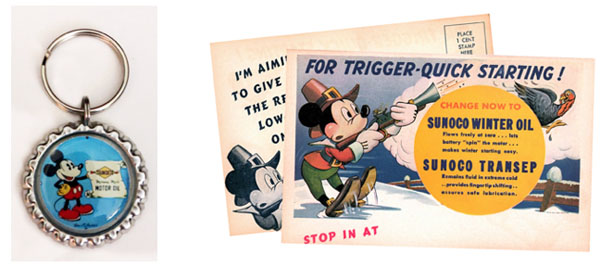
Sunoco keychain and postcard featuring Mickey Mouse. The keychain shows Mickey holding a banner with “Sunoco Mercury Made Motor Oil” on it. You may be wondering, who would send out a postcard from Sunoco? The answer, the independent Sunoco service stations likely used these as a marketing tool to their customers. Mickey firing a musket is no longer permitted under current Disney character guidelines.

The “Defend Your Car’s Life” dated Mar. 1942 shows a rare image of Mickey Mouse in a Military uniform. He is flashing the “V” for victory hand sign while standing behind a caricatured canon made out of a Sunoco oil jar.
The licensing agreement is unusual by The Walt Disney Company’s standards today in that the characters are pitching the Sunoco oil, Nu-Blue fuel, and service brands. Typically today, the Disney characters do not hold, endorse, or overtly pitch third party products. Although the characters today may appear on co-branded products like cereal, they never look like they are pitching or endorsing the product. Yet some of the ad images from the 1930s and 1940s show Donald Duck holding a can of Sunoco oil, Pluto interacting with a branded oil jar, and Mickey Mouse wearing a military uniform and flashing a victory sign behind a Sunoco oil jar oriented as a military cannon complete with tires. The policy for using the Disney characters in co-branding has evolved more strictly since that time.

The “Quick Start” ink blotter featuring Donald Duck was issued in 1938. Sunoco advertised its claim of quick starting motors with the new Blue Sunoco gasoline. The drawing was created in the Disney Publicity Production Department. Most of the ink blotter was created using the offset lithography process.
One of the first ink blotters produced under the new license agreement in 1938 shows Donald Duck in a red coupe convertible being pushed forcefully by a ram with the slogan, “A Quick Start, Blue Sunoco, Peps Up Cold Motors.” Curiously, this blotter has a Disney copyright, but others that were created in 1940 and beyond did not carry any such mark. (13) The lack of copyright is not surprising since there is a significant inconsistency in the use of such marks during that period, especially the WWII years.

The “Flows—Even Below Zero” ink blotter featuring a late 1930s Pluto design. This ink blotter was issued in 1940 and was not drawn by Hank Porter but by an unknown artist in the Disney Publicity Production Department.
Another ink blotter advertisement, circa 1940, features Pluto huffing warm breath onto the base of an outdoor thermometer, wearing mittens on all four paws while his wagging tail appears to have knocked over a quart jar and spout of oil, which is flowing over a sign of Sunoco “W” oil. The slogan on the blotter reads, “Flows– Even Below Zero.” The next blotter from 1940 touts the quick starting Nu-Blue fuel that is “A Hero Below Zero” and shows Donald Duck pinning a medal on a proud gas pump. Canada was already in the war as part of the British Commonwealth. Below the image, it states to “FILL UP TODAY AT” leaving room for the individual service stations to stamp their business name and address. Yet another from 1940 features Mickey Mouse speeding along in a red convertible with the slogan, “UNSURPASSED in mileage” at the top of the blotter with part of that text breaking across one of Mickey’s ears. (14)
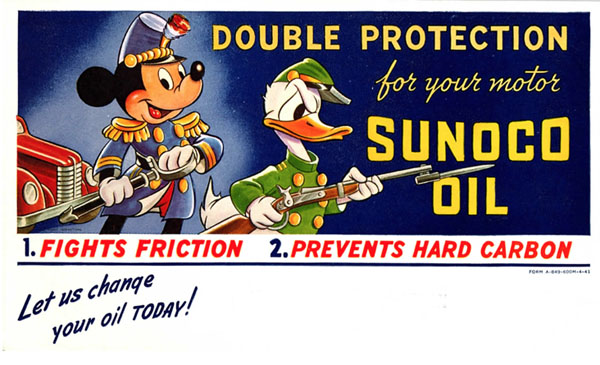
The “Double Protection” ink blotter issued by Sunoco in April 1941. Note the sword and rifle with a bayonet; these are no longer acceptable for cartoon characters to use or even hold according to character guidelines at Disney.
The next ink blotter referenced, from April 1941, shows Mickey Mouse and Donald Duck in uniforms, somewhat reminiscent of the Civil War outfits, complete with epaulets. Mickey is smiling as he appears to be drawing his sword while Donald is visibly angry, carrying a flint-lock rifle complete with bayonet. The ad slogan, “Double Protection For your Motor,” and then states “1. Fights Friction 2. Prevents Hard Carbon” use the words, “Protection, Fights, and Prevents” are implied subliminal messaging of the impending war. These types of messages reflect the broad stroke societal feelings towards the war raging in Europe at the time.
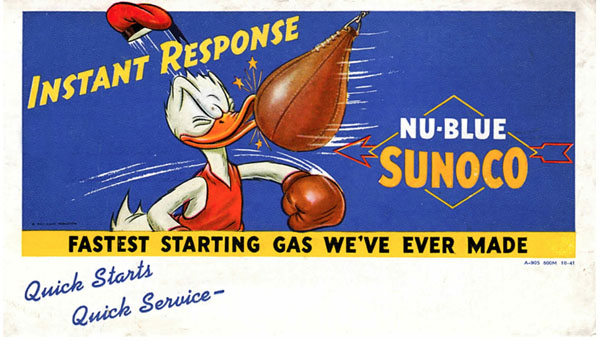
“Instant Response” Sunoco ink blotter featuring Donald Duck getting smacked in the beak. The blank space was left for the individual service stations to stamp their business name and contact information. October 1941
By October 1941, Sunoco released a new ink blotter that featured Donald Duck, in a tank top with boxing gloves on, being hit in the beak by a leather boxing speed bag with the slogan, “Instant Response.” This imagery is no doubt a reference to Canada fighting in the war but can be viewed as a harbinger to the U.S. entering WWII. (15) The character is in a fighting mode as the U.S. would enter the war just two months later on December 7, 1941. The image also evokes a sucker punch to Donald Duck, much like the surprise attack on that occurred on the Pearl Harbor Naval Base. U.S. public opinion was at its highest, with 97% in favor of the war against Japan. (16) America did make an “instant response,” albeit five months later, with the daring Doolittle Raid on Tokyo. (17) As minor as the Sunoco/Disney advertising ink blotters were, they reflected, like so many other things in society at that time, the mood as the U.S. entered the war in both the Pacific and Europe. Note the subtle design change of the Sunoco logo arrow, which previously pointed to the right, now pointing to the left directing the viewer’s eye to the character.
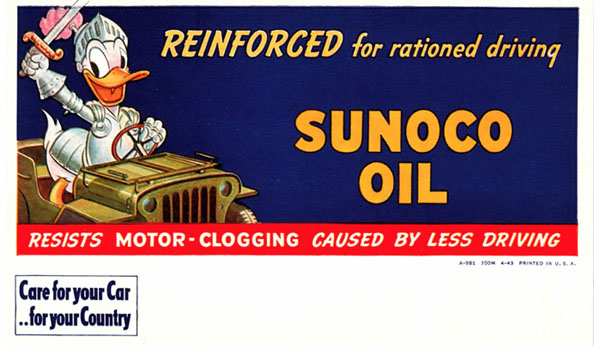
The “Reinforced” Sunoco ink blotter reflects the benefits of Sunoco oil for “Resists Motor-Clogging Caused By Less Driving” due to the fuel rationing that was in effect at that time. April 1943
The Sunoco ink blotters are a microcosm of the war effort in the home front. The April 1943 Sunoco ink blotter reflected the rationing instituted across America due to the war. The blotter proclaimed, “REINFORCED for rationed driving, SUNOCO OIL” and featured Donald Duck in knights armor, sword drawn in the air while driving what appears to be a U.S. Army Willy’s Jeep. In the clear space below the image of Donald is the phrase, “Care for your Car…for your Country.” Regardless of whether a person was in the military or supporting the war effort from the home front, every individual, and company for that matter, was pitching in to make a difference during WWII—hence the moniker “The Greatest Generation.” These and many other patriotic slogans were everywhere during the war—on posters, signage, in advertisements, pamphlets, and on products of all kinds.
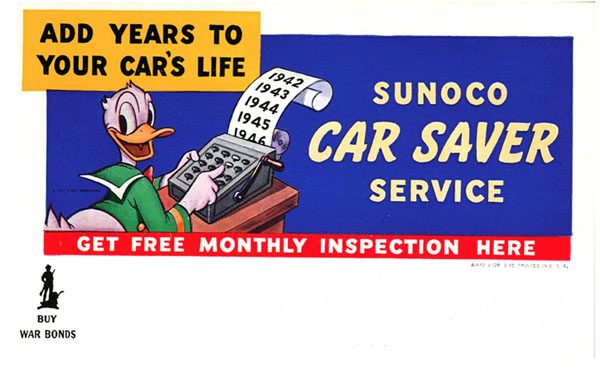
The “Car Saver” ink blotter that features the Buy War Bonds logo for the first time, in September 1942.
In September 1942, the Sunoco ink blotters were not just selling fuel and car services, but they also feature a “Buy War Bonds” logo in support of funding the war effort. (18) This blotter was advertising “Sunoco Car Saver Service” and featured Donald Duck at an adding machine with the slogan, “Add Years To Your Car’s Life.” The ad copy on these is all straightforward and effective advertising messages on roughly 3 ½’ X 6” blotters that were always handy for blotting fresh ink on newly signed orders, checks, service contracts, or any writing done with a fountain pen during that time. The Rule of Seven in advertising states that seven is the “average number of impressions a brand must make on a member of their target market before making a sale.” (19) Giving blotters away with your product information, especially if it were tied to the famous Disney characters, was a sure way of achieving that view count since these blotters lingered on a desk or counter for weeks.

A decidedly patriotic symbol of pinning a medal with the word “hero” used in the tagline. The imagery, although referring to the Sunoco fuel product, is symbolic of the fighting men and women serving their country who are the real heroes.
With WWII in full swing, the ink blotters issued during the war years by Sunoco and others contained at least some reference to the war. Whether it be rationing, war bonds, or just an understandable patriotic feeling, these blotters reflected the we’re all in this together attitude towards the war effort. As optimism set in that the Allies would win the war, the word “Hero” appears with Donald Duck pinning a medal onto a Sunoco gas pump. Is it a positive reinforcement that the tide of the war turned and that an end was near because of the hero U.S. military service members fighting overseas? It is possible since advertising is a timely medium that pivots quickly to capitalize on events of the day. We saw that with 9/11 and are experiencing that recently during the 2020 Covid-19 pandemic.
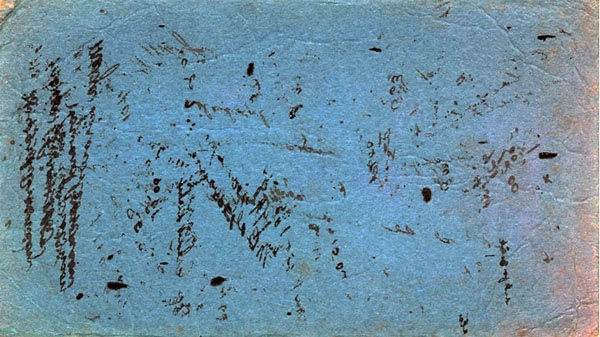
The back of all of the Disney/Sunoco ink blotters were blue. This one shows some fading and discoloration from partial exposure to sunlight. Unlike the advertising side of the blotter, this thin layer of blue paper is highly absorbent and wicks up wet ink quickly, as can be seen in this example.
The absorbent backside of the Sunoco/Disney ink blotters is blue blotter paper. But that was not always the case when blotters became widely used. In the early cotton paper making process, the paper is created using cotton cloth (rags), other fibers, mixed with water and other materials to create the pulp slurry. (20) Red, pink, or orange rags were discarded due to the difficulty in getting rid of those colorations. But when the blotter paper was mistakenly made centuries ago, the reddish rags found an excellent use after that. Early examples of ink blotters, for the most part, are pink in color. As the papermaking process evolved and became industrialized, the blotter color no longer needed to be pink and could be any color desired. The blue of the Sunoco/Disney ink blotters is a complementary color to the often lighter backgrounds found on the front advertisements.
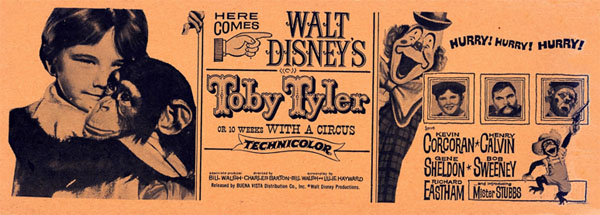
The “Toby Tyler” movie advertisement ink blotter from 1960 is possibly one of the last times that Disney or a Disney movie/characters appeared on an advertising ink blotter. By this time, ballpoint pens were inexpensive, widely available, and very reliable. The usefulness of ink blotters quickly faded by the early 1960s.
With the invention of Hungarian journalist László Bíró’s ballpoint pen, patented in 1938, the golden age of the fountain pens began to fade away slowly after WWII. By the 1960s, companies like Paper Mate, Parker Pens, and Bic saturated the market with inexpensive disposable pens that were ubiquitous and reliable. The advertising ink blotters faded away with the fountain pen. However, Disney did produce an advertising ink blotter for the release of Toby Tyler (1960), a live-action film starring Kevin Corcoran as Toby Tyler. The latter runs away from his foster parents to join the circus where he meets the irresistible chimpanzee, Mr. Stubbs. Beyond that, there is little evidence that ink blotters were used for advertising any other Disney related products after that point.
Fountain pens today are viewed more as a luxury item and status symbol. There is an “air of timeless elegance, personalization, and sentimentality associated with fountain pens” that lacks in the coldness of the computer keyboard or the utilitarianism of a ballpoint pen. (21) Writing with a fountain pen is a unique sensory experience. You can hear the gliding metal nib over the textured paper as it feeds a thin line of ink out the tip as you feel the gyrating motion of your hand moving about the surface seeing words form, your unique thoughts, permanently captured in time. If the ink were still wet, you would take a moment to use that advertising blotter on your desk to quicken the drying process as you gave thought about the next phrase to write.
Writing by hand used to be almost ritualistic in the days before ballpoint pens, cell phones, and computers. It was a slower time when thought, for a moment, was given before writing a sentence. The Sunoco/Disney ink blotters are a reminder of that bygone era and one of the many everyday items that most never gave much thought to other than a passing glance at the advertisement as they blotted fresh ink. Still, many have survived the passage of time, becoming a collectible form of ephemera, especially the ones that feature the Disney characters. These simple, disposable ink blotters are just another example of the many untold stories still out there in the ephemera and Disney universe.
©2021 David A. Bossert
This essay first appeared in the Ephemera Society of America Journal in January 2021.
FOOTNOTES
1 – Pen, split nib – Romano-British period, British Museum
2 – Bosworth, A Mediaeval Islamic Prototype of the Fountain Pen?, Journal of Semitic Studies, 1981, pg.229–234.
3 – Nishimur, David, Who Invented The Fountain Pen? Vintage Pens, 1997.
4– Rickards, Maurice, Encyclopedia of Ephemera: A Guide to the Fragmentary Documents of Everyday Life for the Collector, Curator, and Historian, Routledge 2000, pg. 55.
5 – Dard Hunter, Papermaking through Eighteen Centuries; New York: William Edwin Rudge, 1930), pg. 141
6 – Campaign Ink Blotters, History, Art & Archives: United States House of Representatives, March 12, 2018.,
7 – Examples of these are part of a private collection.
8 – Arlington Trust Company of Massachusetts ink blotters, from a private collection.
9 – Based on analysis of the drawings, the Walt Disney signatures, and consultation with Historian and Hank Porter biographer David Lasjak.
10 – Correspondence with historian and Hank Porter biographer David Lesjak, July 5, 2020.
11 – Mickey Mouse Nu-Blue Sunoco Sign: Vintage Disney Licensed Advertising, Art Factory, 2019
12 – Invention of the Custom Blending Pump, 1956, www.sunoco.com
13 – Sunoco Ink Blotter, 1938
14 – Sunoco Ink Blotter, 1940
15 – Sunoco Ink Blotter, 1941
16 – Inc., Gallup. Gallup Vault: A Country Unified After Pearl Harbor, Dec. 12—17, 1941; Gallup.com.
17 – Horne, Alistair, Payback for Pearl: Doolittle’s Raiders avenged Pearl Harbor by hitting the Japanese where they least expected it—at home, MHQ—The Quarterly Journal of Military History, Spring 2012
18 – Sunoco Ink Blotter, 1942
19 – Stevens, John, Using the Rule of 7 to Radically Grow Your Business, The Balance/Small Business, Feb. 04, 2020 www.thebalancesmb.com.
20 – Hunter, Dard, Papermaking, the history and technique of an ancient craft, Dover 1943.
21 – Yoko Hani, Find out why a fountain pen ‘personalizes’ your prose. Japan Times, Dec.24, 2006.


 David A. Bossert is an award-winning artist, filmmaker, and author. He received his B.A. from CalArts School of Film and Video with a major in Character Animation. As a 32-year veteran of The Walt Disney Company, he contributed his talents to The Black Cauldron (1985), Who Framed Roger Rabbit (1988), The Little Mermaid (1989), Beauty and the Beast (1991), Aladdin (1992), Tim Burton’s The Nightmare Before Christmas (1993), The Lion King (1995), Fantasia/2000 (1999), and the Academy Award-nominated shorts Runaway Brain (1995), Dali/Disney Destino (2003), and Lorenzo (2004), among many others. Bossert is now an independent producer, creative director, and writer.
David A. Bossert is an award-winning artist, filmmaker, and author. He received his B.A. from CalArts School of Film and Video with a major in Character Animation. As a 32-year veteran of The Walt Disney Company, he contributed his talents to The Black Cauldron (1985), Who Framed Roger Rabbit (1988), The Little Mermaid (1989), Beauty and the Beast (1991), Aladdin (1992), Tim Burton’s The Nightmare Before Christmas (1993), The Lion King (1995), Fantasia/2000 (1999), and the Academy Award-nominated shorts Runaway Brain (1995), Dali/Disney Destino (2003), and Lorenzo (2004), among many others. Bossert is now an independent producer, creative director, and writer.













































































Thank you for this amazing article! A heretofore unknown (to me) chapter in Disney history. Plus a summary of the history of ink and blotting. Those examples shown are a fascinating look at a bygone era.
I still don’t fully “get” the concept of ink blotting, but this is not in any way a fault of this article. It’s just that having lived all my life with “clickable” pens I’ve never had to concern myself with blotting ink.
I will have to read this again later. There is so much information packed into it. I greatly appreciate the research that went into this. It’s fascinating that there is still much to discover about early Disney.
Hi Frederick, Glad you enjoyed the article. The blotting ink concept is based on the fact that the ink, from a fountain or quill tipped pen, is wet for a period once applied to a paper document, and the blotter is used to hastens the drying process by absorbing some of the wet ink. Using a ballpoint pen, you don’t have that issue since the ink is dry nearly instantly as it is applied. Hopefully, that makes it more clear. Best, -Dave
My mother was a secretary for many years, and we had a lot of antiquated office equipment around our house. I remember a blotter, made of some kind of hardwood, with a handle on top and a curved surface beneath. You attached the blotting paper to the lower surface and then rolled the blotter over the document. I suppose it would have come in handy if you had to do a lot of blotting in a hurry.
I had no idea that blotting paper was ever used for advertising. Somehow I don’t think it would have gone over well in the law offices where my mother worked (though she loved Mickey Mouse). Besides, the blotting device described above would have reduced the effect of any advertisement, as you would only glance at it when you were attaching the blotting paper to the blotter, and then again when you threw the blotting paper away. I guess that’s where the Rule of Seven comes in.
Any discussion of blotting paper reminds me of a story about the palaeontologist Henry Fairfield Osborn, longtime director of the American Museum of Natural History and a man renowned for his extreme arrogance and pomposity. He once gave the younger palaeontologist George Gaylord Simpson a present: one of Osborn’s own books, which he proceeded to autograph. But when Simpson automatically reached for the blotter, Osborn reacted with horror. “Never blot a great man’s signature!” he said.
Hi Paul, Glad that you enjoyed the article and that it brought back some memories. These adverting blotters were used on their own and not with the many different blotter handles made of everything from hardwood to bronze and silver. The handles are an entire other area of collecting. Great story about Osborn! Thank you, -Dave
Nice article, Dave. I especially like your descriptive powers in the PENultimate paragraph about the romance of writing with a fountain pen, even to the SOUND that the pen makes as it drags across the page. I love inking drawings with dip pens, but never blot the drawings, sometimes I “wick” them with a bit of tissue if the ink blobs or is too wet in spots. The wood blotters that Paul Groh describes are characterized in “The New Spirit” as Donald pays his taxes. The story folks also turned a fountain pen into a character in that picture as well. (And just a friendly aside, “CANNON” is spelled with two “N”s not one.)
Thanks, Mark! Glad you enjoyed the article.
I’m sure that Jerry will be able to make the adjustment to cannon.
Excellent article and something no one else has ever covered, certainly not to this extent, in all my decades of reading Disney related articles. I have three different Sunoco Disney blotters and was always curious to know more about them. You answered all my questions and more. It did take me a while to learn how to correctly pronounce “Sunoco”. Thanks for sharing this information.
Hi Jim, Thank you! I appreciate your kind words and glad that you enjoyed the piece. I find those ink blotters to be fascinating pieces of ephemara, especially from the WWII era. I have others in my collection from the early 30s that are not war-related. The common denominator is that the Disney characters are wonderfully drawn. Best, -Dave
Great post. Makes me wish there was a proper Disneyana blog on the web.
This was very interesting, but I do not understand how this type of blotter was used. The rolling kind with a handle, sure, but these? Did you hover over the area to be blotted and drop this on? How thick are these? Thanks!
Hi Dan, These advertising blotters were used by just laying the absorbent side down on the fresh ink. I’ve just rolled it with my hand as these ink blotters are about as thick as thin cardboard or chipboard but more pliable. Think of how you would hold a folded napkin when you wiped up something that dripped on a table. I hope that brings further clarity to the blotter usage. Thanks for reading the piece. -Dave
In addition to “The New Spirit”, an old-fashioned handled blotter appears in Fleischer’s “The Cobweb Hotel”. Honeymooning newlyweds “I. Fly and wife” use it as a seesaw. I know I’m going to notice these things a lot more from now on!